The Big Picture
By Colin Twiggs
February 27, 2007 5:00 a.m. ET (9:00 p.m. AEDT)
These extracts from my trading diary are for educational purposes and should not be interpreted as investment advice. Full terms and conditions can be found at Terms of Use.
The Big Picture
Ten-year treasury yields are headed for another test of the 3-year trendline. Respect of the trendline would signal a test of resistance at 5.25%, while failure would warn of reversal to a down-trend. Lower treasury yields encourage higher PE ratios in the stock market; higher yields indicate the opposite.
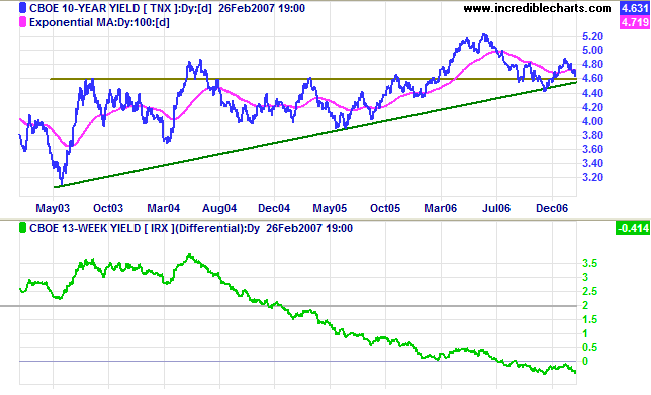
The negative yield differential (10-year minus 13-week treasury yields) is increasing, warning of pressure on banking margins and a possible down-turn.
Equity Markets
The primary trend on the Dow Jones Industrial average is up. Volume has been falling over the past 6 to 8 months and Twiggs Money Flow shows a bearish divergence; two reasons why this is not a good time to enter the extended rally.
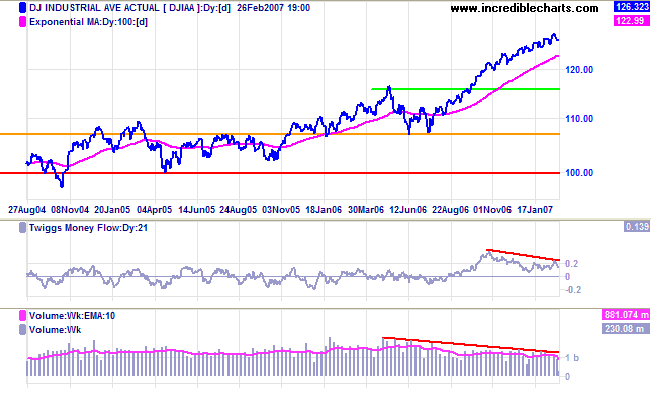
Gold
Spot gold broke through resistance at $675 after a brief
retracement back to $660. A retracement that tests the new
support level of $675 is likely, while a rally that goes
straight on to test the May 2006 high would signal buyer
commitment. A fall below $675, though unlikely at present,
would signal that the up-trend is losing momentum.
Rising crude oil prices are likely to increase demand for gold:
(a) as an inflation hedge; and (b) as OPEC producers tend to
buy gold with surplus funds. A weaker dollar would also boost
gold prices, but this is not yet evident.
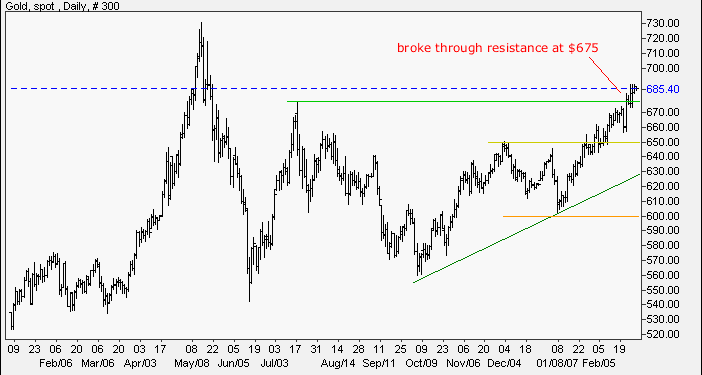
Source: Netdania
Crude Oil
Crude oil broke through resistance at $60/barrel after a brief retracement. The breakout indicates that the down-trend may reverse, but this would only be confirmed if there is a rise above $64. I am always wary of V-bottoms: they have a strong tendency to become W-bottoms or, at least, inverted head and shoulders.
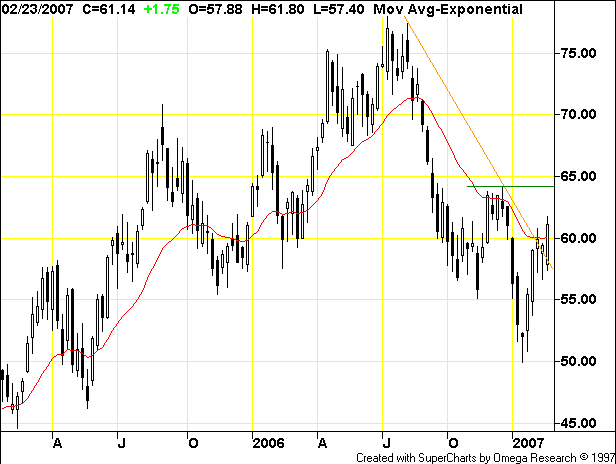
Currencies
The euro has rallied above support at $1.29/$1.30 and appears headed for a test of resistance at $1.34. If $1.34 is penetrated, expect substantial resistance at the 2005 high of $1.37.
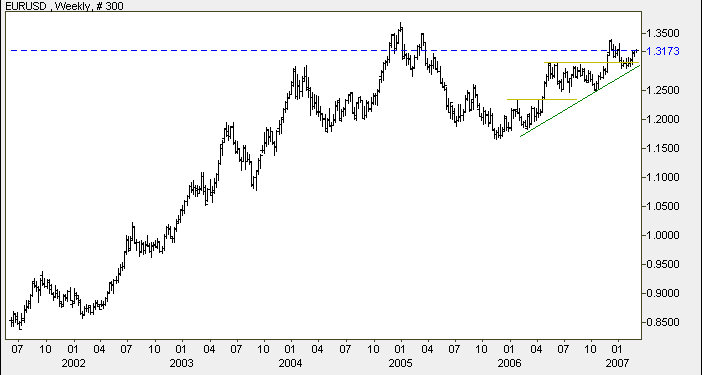
Source: Netdania
The dollar is forming a bullish consolidation below the important resistance level of 121 against the yen, after a false downward break. A fall below 115, while still unlikely, would signal a test of long-term support at 100. Reversal above 121, on the other hand, would be a bull signal for the dollar.
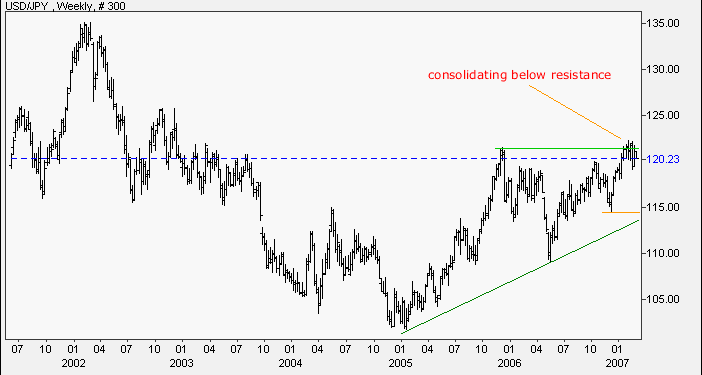
Source: Netdania
Wright Model
Probability of recession in the next four quarters has leveled off at 45 per cent according to the Wright Model.
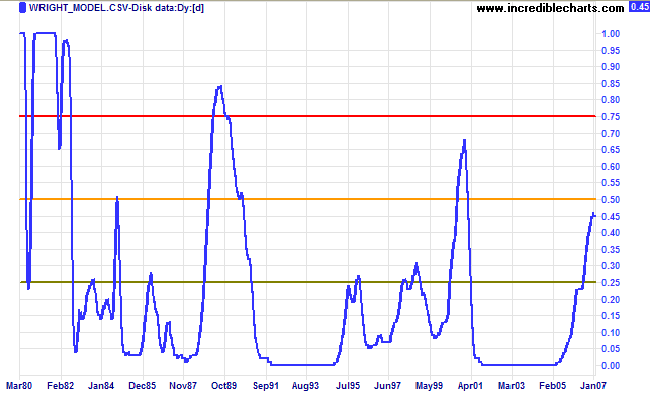
There is some evidence that the Wright model may understate the probability of recession in a low interest rate environment (as at present).
A more instructive analogy is between inflation and alcoholism.
When the alcoholic starts drinking, the good effects come
first; the bad effects only come the next morning when he wakes
up with a hangover -- and often cannot resist easing the
hangover by taking "the hair of the dog that bit him".
~ Milton Friedman: Free To Choose
Technical Analysis and PredictionsI believe that Technical Analysis should not be used to make predictions because we never know the outcome of a particular pattern or series of events with 100 per cent certainty. The best that we can hope to achieve is a probability of around 80 per cent for any particular outcome: something unexpected will occur at least one in five times.My approach is to assign probabilities to each possible outcome. Assigning actual percentages would imply a degree of precision which, most of the time, is unachievable. Terms used are more general: "this is a strong signal"; "this is likely"; "expect this to follow"; "this is less likely to occur"; "this is unlikely"; and so on. Bear in mind that there are times, especially when the market is in equilibrium, when we may face several scenarios with fairly even probabilities. Analysis is also separated into three time frames: short, medium and long-term. While one time frame may be clear, another could be uncertain. Obviously, we have the greatest chance of success when all three time frames are clear. The market is a dynamic system. I often compare trading to a military operation, not because of its' oppositional nature, but because of the complexity, the continual uncertainty created by conflicting intelligence and the element of chance that can disrupt even the best made plans. Prepare thoroughly, but allow for the unexpected. The formula is simple: trade when probabilities are in your favor; apply proper risk (money) management; and you will succeed. For further background, please read About The Trading Diary. |

Author: Colin Twiggs is a former investment banker with almost 40 years of experience in financial markets. He co-founded Incredible Charts and writes the popular Trading Diary and Patient Investor newsletters.
Using a top-down approach, Colin identifies key macro trends in the global economy before evaluating selected opportunities using a combination of fundamental and technical analysis.
Focusing on interest rates and financial market liquidity as primary drivers of the economic cycle, he warned of the 2008/2009 and 2020 bear markets well ahead of actual events.
He founded PVT Capital (AFSL No. 546090) in May 2023, which offers investment strategy and advice to wholesale clients.
